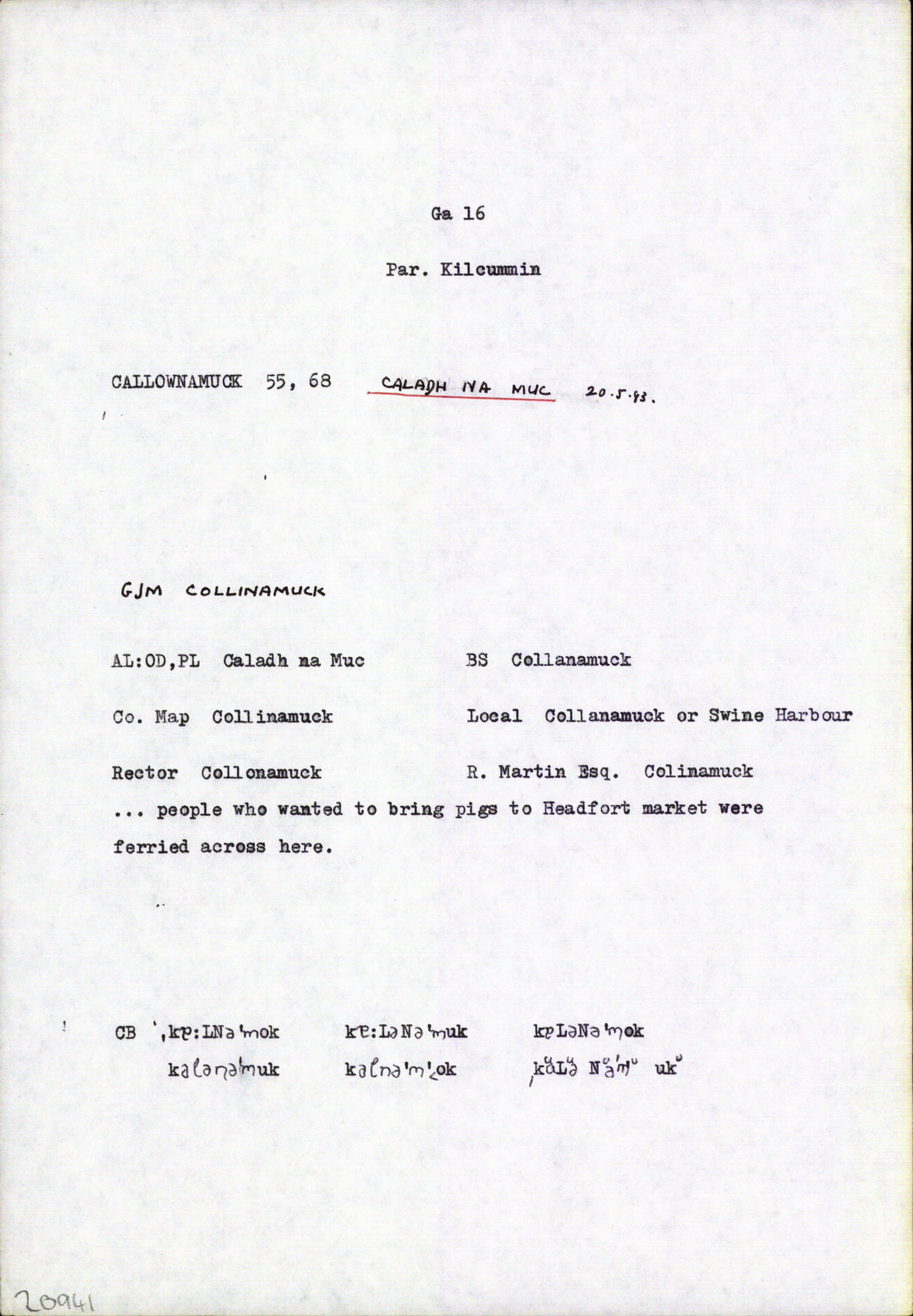Hierarchy
county
barony
civil parish
townland
subunits
Other names
Hierarchy
county
barony
civil parish
Explanatory note
- Gaeilge
the callow, landing-place of the pigs
Is minic a bhíonn an bhrí “landing-place”, “port” nó “harbour” leis an bhfocal caladh agus, go deimhin, léirítear landing place sa bhaile fearainn seo, atá suite ar bhruach Loch Coirib, ar léarscáil de chuid na Suirbhéireachta Ordanáis ó thús an 20ú haois. Bhailigh foireann na Suirbhéireachta eolas faoi bhunús an ainm sna 1830í:
people who wanted to bring pigs to Headfort market were ferried across here (Descriptive Remarks; as Ainmleabhar Paróiste na Suirbhéireachta Ordanáis)
Feictear míniú den chineál céanna ar bhunús an ainm i mBailiúchán na Scol ó na 1930í:
An fáth gur baisteadh an t-ainm seo ar an áit:- Fadó beathuightí a lán muc annseo. Cuirtí go Gaillimh iad i mbádaibh ó'n gcaladh-phort thíos. Tugadh an t-ainm “Caladh na Muc” ar an gcaladhphort ar dtús agus leis an am tugadh an t-ainm ar an t-sráid-bhaile ar fad (0065, 002).
Léireodh an méid sin go bhfuil an-dealramh le “the landing-place of the pigs” mar mhíniú ar Chaladh na Muc. Bíodh sin mar atá, tá brí eile leis an bhfocal caladh a bheadh feiliúnach mar mhíniú ar an logainm seo. Is é sin “callow”, “river-meadow” (talamh íseal lámh le huisce). Feictear an focal sa bhrí sin sa logainm Calaí na Sionainne/River Shannon Callows, agus i dtagairt stairiúil den logainm Loch Uí Ghadhra/Lough Gara faoin mbliain 1393 in Annála Ríoghachta Éireann (iv 726.14) 'i ccaladh locha techet' ('at the callow of Lough Techet', DIL), mar shampla. Ar an ábhar sin, díol suntais is ea go bhfuil flooded marcáilte ar an gcéad eagrán de léarscáileanna sé orlach na Suirbhéireachta Ordanáis i gcodanna den bhaile fearainn seo; cf. Liable to Floods ar bhruach an locha ar léarscáileanna an 20ú haois. D’fhéadfadh sé gurb é “the callow of the pigs” an bhunbhrí a bhí le Caladh na Muc, mar sin, agus gur athmhíníodh an t-ainm ní ba dheireanaí. (JÓG)
- English
the callow, landing-place of the pigs
The word caladh frequently signifies “landing-place”, “port” or “harbour”. In this townland situated along the banks of Lough Corrib, there is indeed a Landing Place marked on Ordnance Survey maps dating back to the early 20th century. The staff of the Survey collected information on the origin of this placename in the 1830s:
people who wanted to bring pigs to Headfort market were ferried across here (Descriptive Remarks; Ordnance Survey Parish Namebooks)
A similiar explanation is provided in the Schools’ Folklore Collection from the 1930s:
An fáth gur baisteadh an t-ainm seo ar an áit:- Fadó beathuightí a lán muc annseo. Cuirtí go Gaillimh iad i mbádaibh ó'n gcaladh-phort thíos. Tugadh an t-ainm "Caladh na Muc" ar an gcaladhphort ar dtús agus leis an am tugadh an t-ainm ar an t-sráid-bhaile ar fad. [The reason this name was given to the place: Long ago many pigs were reared here. They were brought to Galway in boats from the harbour below. The name “Caladh na Muc” was given to the harbour first and over time the name was given to the whole village] (0065, 002).
All of the above would seem to suggest that “the landing-place of the pigs” is the likely meaning of Caladh na Muc. That being said, caladh can often signify “callow”; “river-meadow” (i.e., low-lying land next to a waterway) in placenames. This meaning is evident in the placename Calaí na Sionainne/River Shannon Callows and in an historical reference to Loch Uí Ghadhra/Lough Gara in The Annals of the Four Masters under the year 1393 (iv 726.14) 'i ccaladh locha techet' ('at the callow of Lough Techet', DIL). In this respect it is worth noting that areas of this townland are marked as being flooded in the first addition of the Ordnance Survey six-inch maps; cf. Liable to Floods on the shore of the lake on 20th century maps. It may be the case, therefore, that Caladh na Muc originally carried the meaning “the river-meadow of the pigs” but that the name was later reinterpreted as “the landing-place of the pigs”. (JÓG)
Centrepoint
Please note: Some of the documentation from the archives of the Placenames Branch is available here. It indicates the range of research contributions undertaken by the Branch on this placename over the years. It may not constitute a complete record, and evidence may not be sequenced on the basis of validity. It is on this basis that this material is made available to the public.
Archival and research material provided on this site may be used, subject to acknowledgement. Issues regarding republication or other permissions or copyright should be addressed to logainm@dcu.ie.

